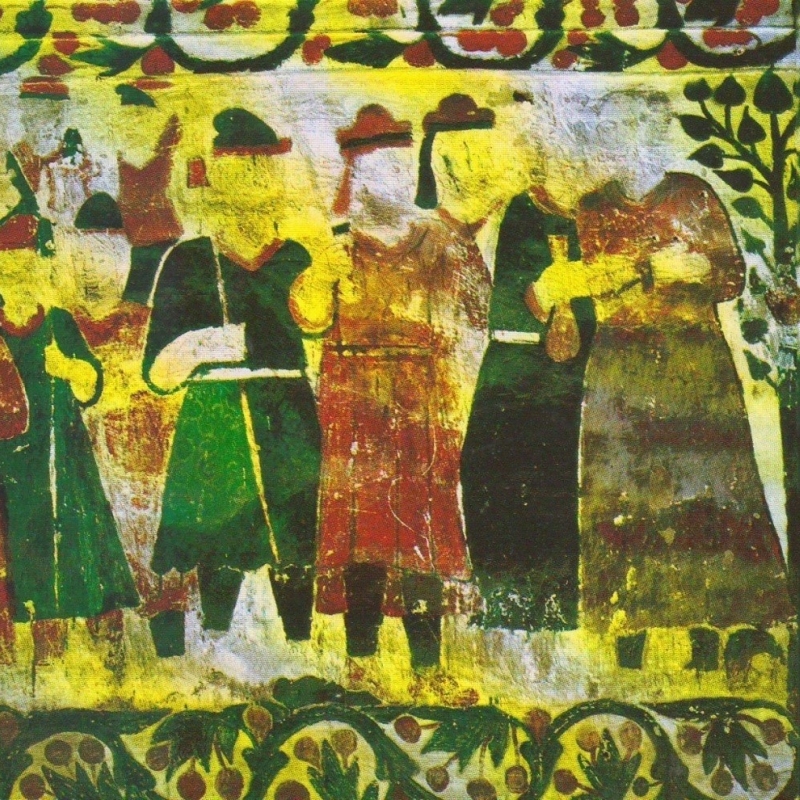Introduction
Paintings executed on plastered wall surfaces are called mural paintings. These are one of the most valued aesthetic art forms, and effectively portray the cultural legacy of the region they belong to. Kerala is well-known for its mural tradition. This remarkable art form has thrived through temples, palaces and churches under the aegis of religiosity. Church murals have contributed immensely to the field of art. The paintings on the walls of the churches of Kerala are surviving records of the history and chronology of Christianity in the region.
Christianity is one of the prominent religions of Kerala. Of its numerous churches, many are popular Christian pilgrimage centres and many of the old churches are testimonies to the exquisite architectural traditions followed by the Christians of the region.
The church is a place of worship and a congregational meeting place for persons of the faith. Its architectural elements include a dwajastambham (flagstaff) with a small cross on top. The garbhagriha (congregation area) is located inside the main building. This part may be lined with pews, altar, baptismal area and pulpit. The altar is the most important part of the congregation area and the most visible and attractive part of the church. It is decorated with carvings, paintings, brass, glass and sometimes wood. The other important decorated structures are called pulpits, frequently seen as a raised enclosed platform placed close to the walls. Church buildings also may have decorated gopurams (gateways), oottupura for serving food to pilgrims and worshippers, and cemetery for the use of congregation priests and other members of the community. The main entrance has a series of stone steps. Churches have many structural similarities to temples, the main distinguishing feature being a cross on its top.
From the seventeenth century CE walls and ceilings of altars of some churches in Kerala began to be decorated with wood carvings or paintings. The themes depicted here are mainly biblical, providing a spiritual and religious atmosphere to the worshippers.
The Earliest Surviving Church Murals
The earliest surviving specimens of Church murals in Kerala can be seen at the St. Mary’s Jacobite Syrian Church at Angamali, St. Mary’s Church at Kanjoor in Ernakulam District, St. Mary’s Orthodox Syrian Church at Kottayam (Kottayam Cheriapalli), St. Francis Xavier Forane Church at Velur, St. Lazar’s Church at Kottapady and St. Anthony's Forane Church at Ollur in Thrissur District and St. George Orthodox Church at Cheppad in Alappuzha District. The colour and stylistic parameters of these paintings show that they were painted from the 16th CE onwards. Murals in some of the churches have been partially destroyed due to the demolition of the buildings along with their rich artistic and historical heritage. The murals of St. Mary’s Jacobite Syrian Church at Angamali and St. Mary’s Church at Kanjoor in Ernakulam district and St. Mary’s Orthodox Syrian Church in Kottayam district are briefly described here and are compared with the temple murals in Kerala.
1. St. Mary’s Jacobite Syrian Church at Angamali (10.1906°N,76.3828°E)
St. Mary’s Jacobite Syrian Church is one of the most renowned and ancient churches of Kerala, located near Angamali in Ernakulam district (see fig. 1). This west-facing church has the typical Kerala style church architecture and is believed to have been built in 409 CE. The stone inscription and mural paintings make it archaeologically important.
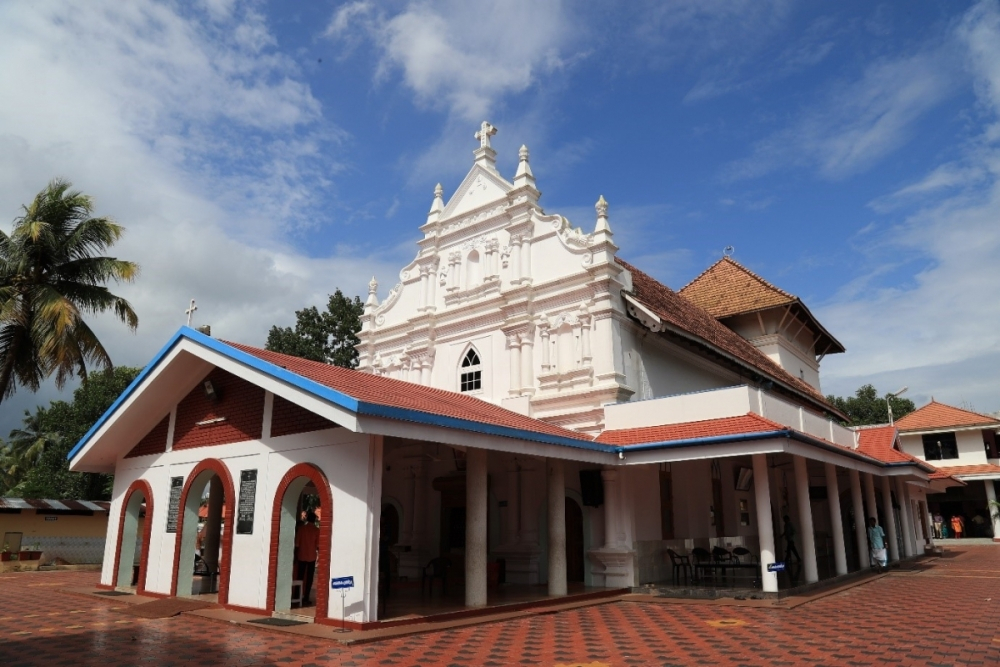
Mural Paintings
The depiction of the Last Judgement and Hell in St. Mary’s Jacobite Syrian Church are among the most beautiful church murals in Kerala. They are also among the largest mural panels in the state. The paintings are depicted on the sidewalls of the prayer hall, in front of the madbaha (sanctum sanctorum).
The scene of the Last Judgement (see fig. 2) is arranged in six rows, with each row separated by the depiction of cloud fragments arranged in a line. At the top of this panel is the picture of God the Father with angels. Below this is the image of Jesus (holding a cross). On either side of Jesus, 13 people are shown, seven on his right and six on his left. To the left end of this row, we have the image of Mother Mary in a blue robe and golden crown. The right end has St. Thomas. Angels are depicted in the third row. Below this, there is a panel which has the image of three Arch Angels, one of them is depicted as playing a double trumpet, one holding a sword and the other holding a bunch of flowers. The panel below has the image of holy people. All of them are wearing similar costumes and have smiling faces. Some are depicted with folded hands and some are seen to be wearing crocodile type hair accessory. Among them, one man is shown carrying a book. The figure most probably represents an authority figure of the church like the Bishop or the Vicar. Behind this figure, a king holding a musical instrument is represented. This may be King David, from the Old Testament. Below this panel, there is an image of people arranged in two groups, one on the left and the other on the right. The left group shows the wicked, arranged in a disorderly manner. Their faces express anxiety, fear or sadness. Some of them are nude and hiding their faces with their hands. Among them, one is in royal garb and maybe Pontius Pilate who convicted Jesus. The right group consists of holy men and women.[1]
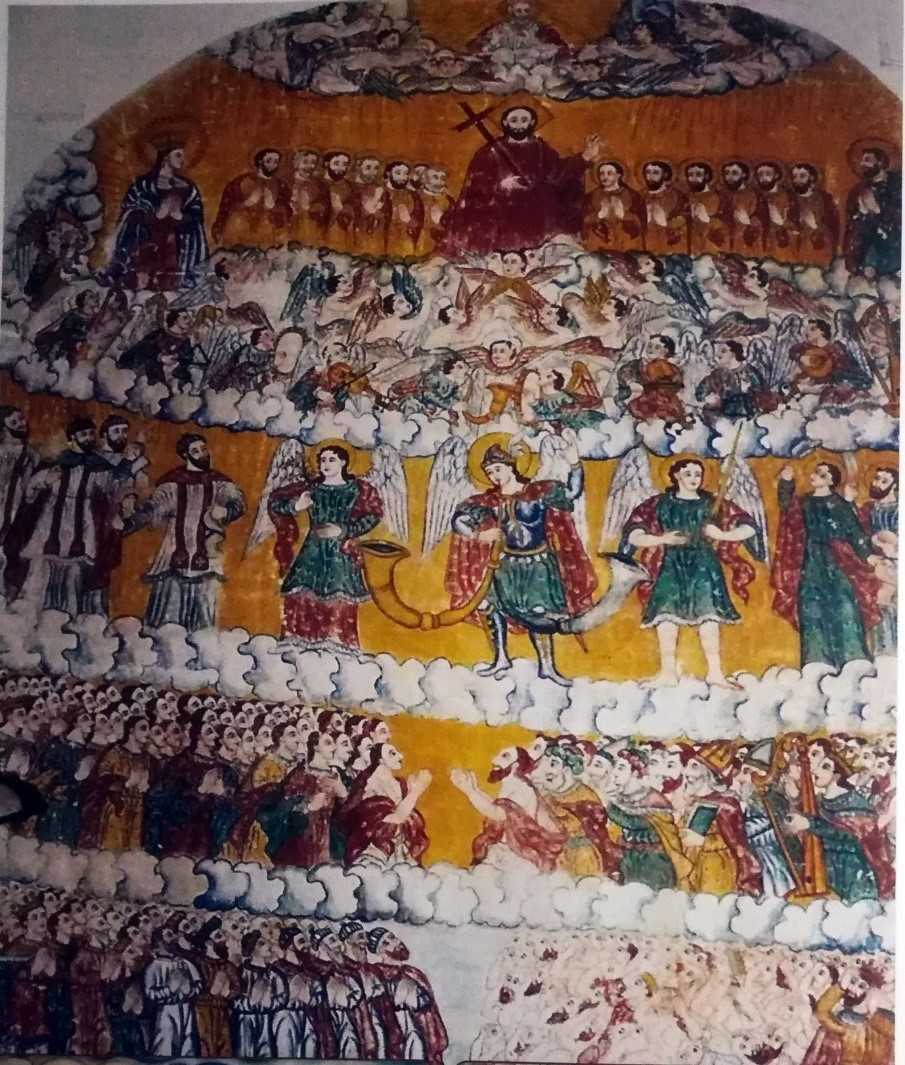
Another noteworthy image in this church is the depiction of Hell (see fig. 3). The figures are arranged chaotically on the wall surfaces. There are human figures and devils. The background of this panel is delineated by a reddish, flame-like representation. It is a traditional Christian belief that hell is a place with never-ending fire. The most attractive figure in this panel is at the top and resembles the Hindu goddess Kali; depicted with bulging eyes, protruding canines, fierce look and wearing a serpent canopy as a hair ornament. The figure carries a trident in the right hand (see fig. 4). This could be the representation of the head of the devils, Lucifer. Below this panel, the mural showcases the miseries and vagaries of hell, the punishments and persecutions. The nature of punishment is written in the old Malayalam script (see fig. 5). The devils are depicted with an expression of joy on their faces, playing musical instruments like the drum and trumpet and holding colourful umbrellas.[2]
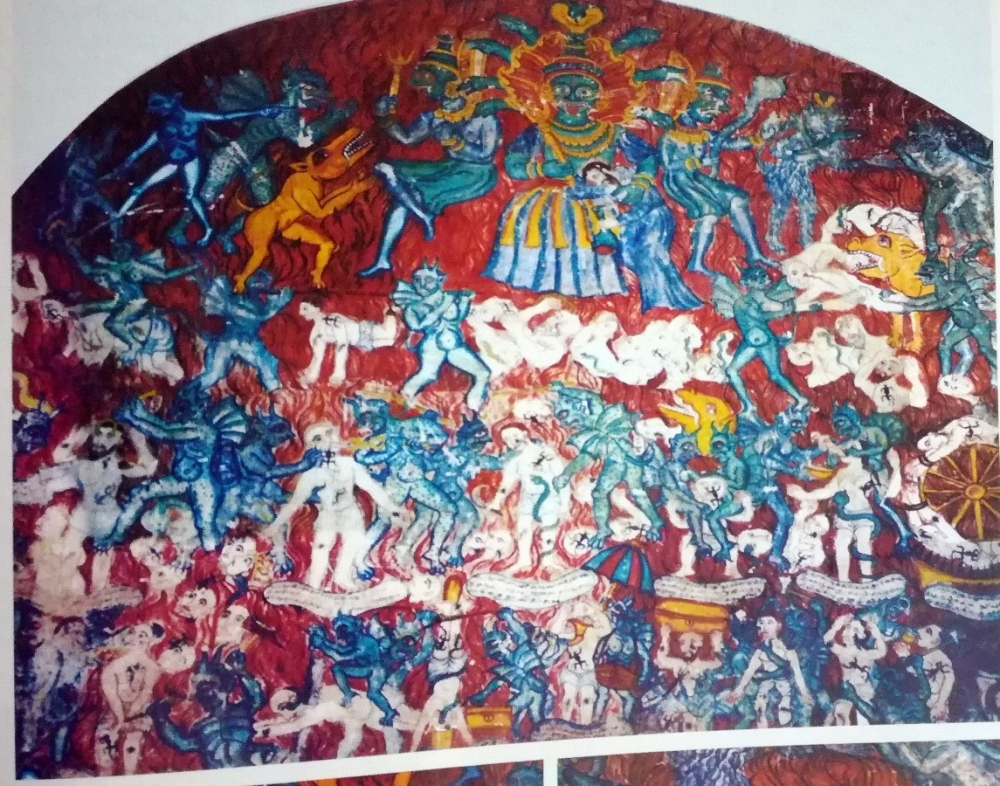
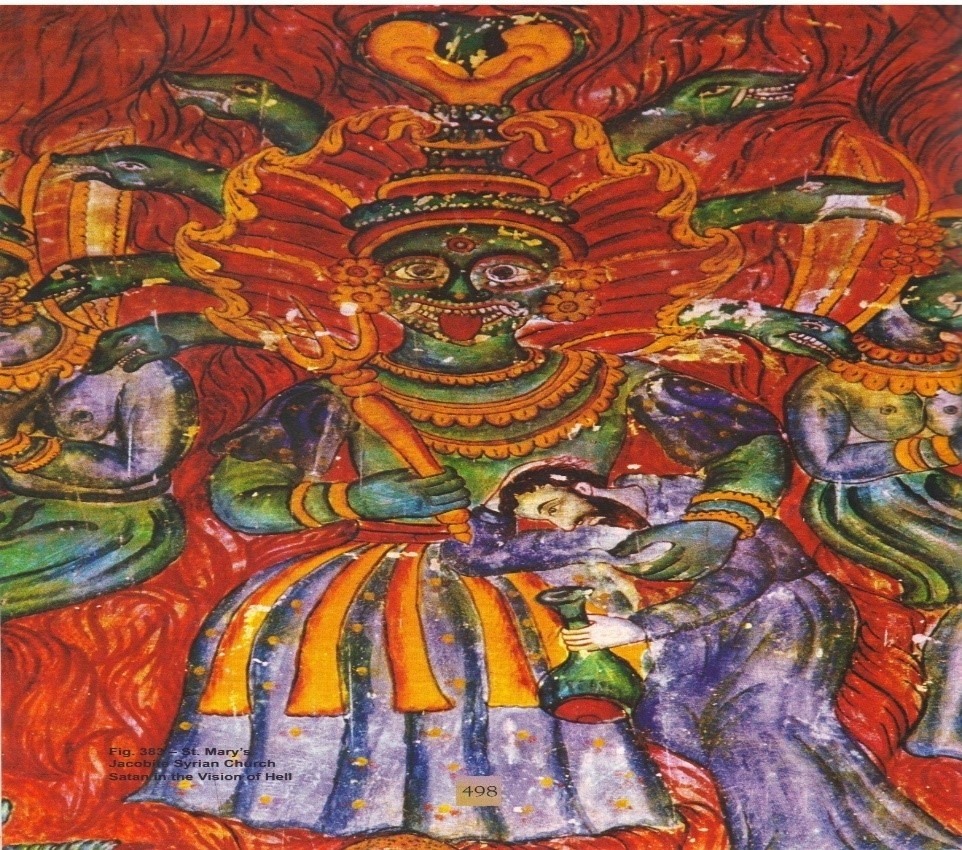
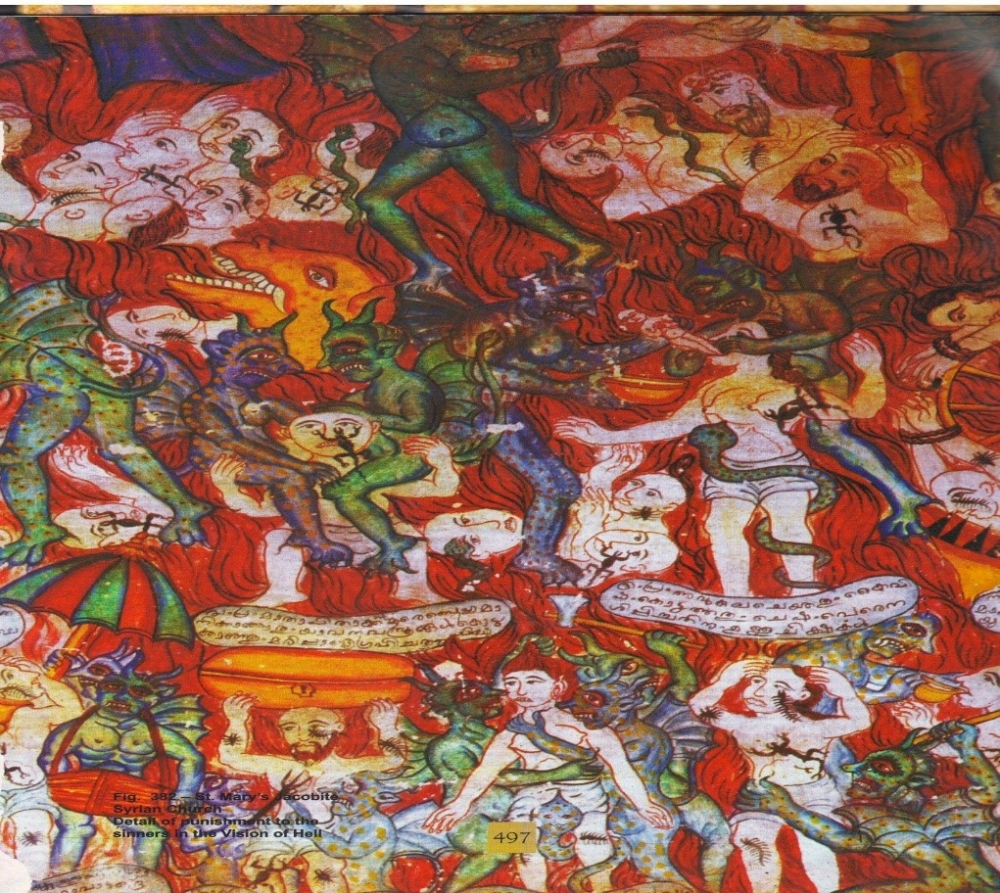
Other important images in this church are the representations of the Crucifixion (see fig. 6), Abraham’s sacrifice of Isaac (see fig. 7), and the representation of Adam and Eve (See fig. 8). These paintings are sublime and vibrant portrayals executed with clarity and in bright colours. Adam and Eve are shown inside the garden. Eve is attracted by the devil, coming out from the mouth of a dragon. The devil gives the fruit to Eve. Adam is shown seated and staring at them.
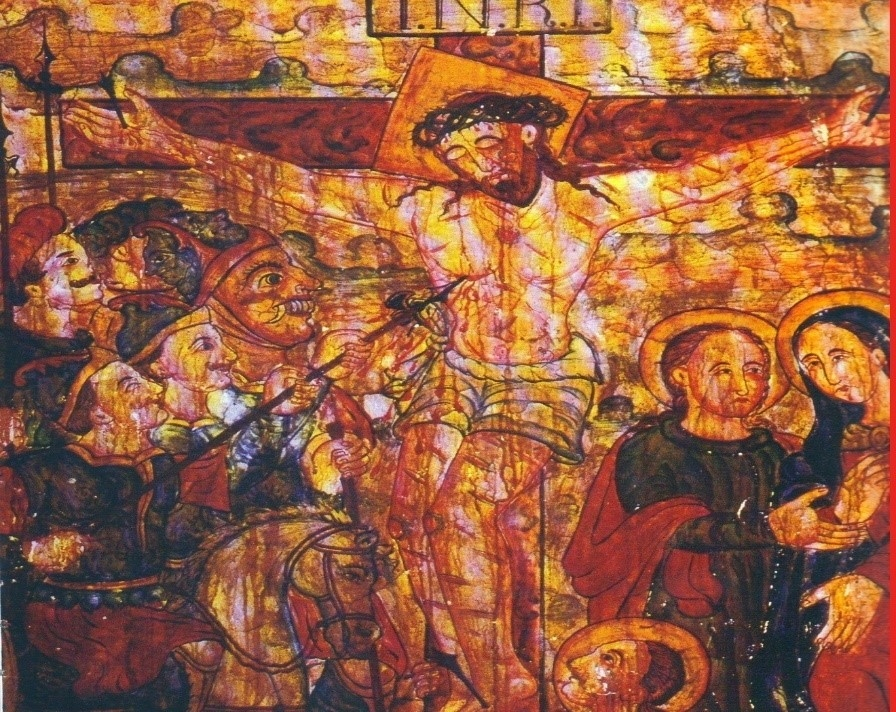
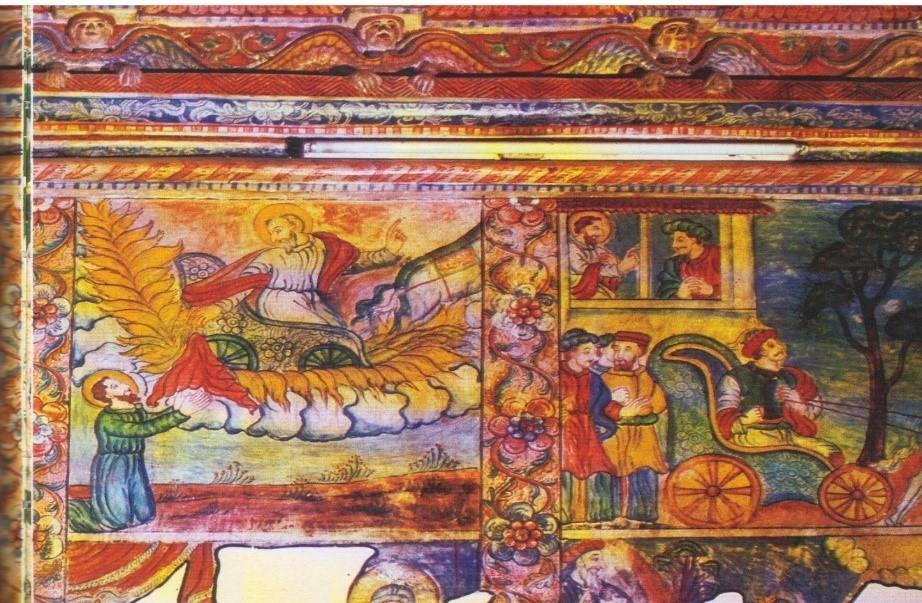
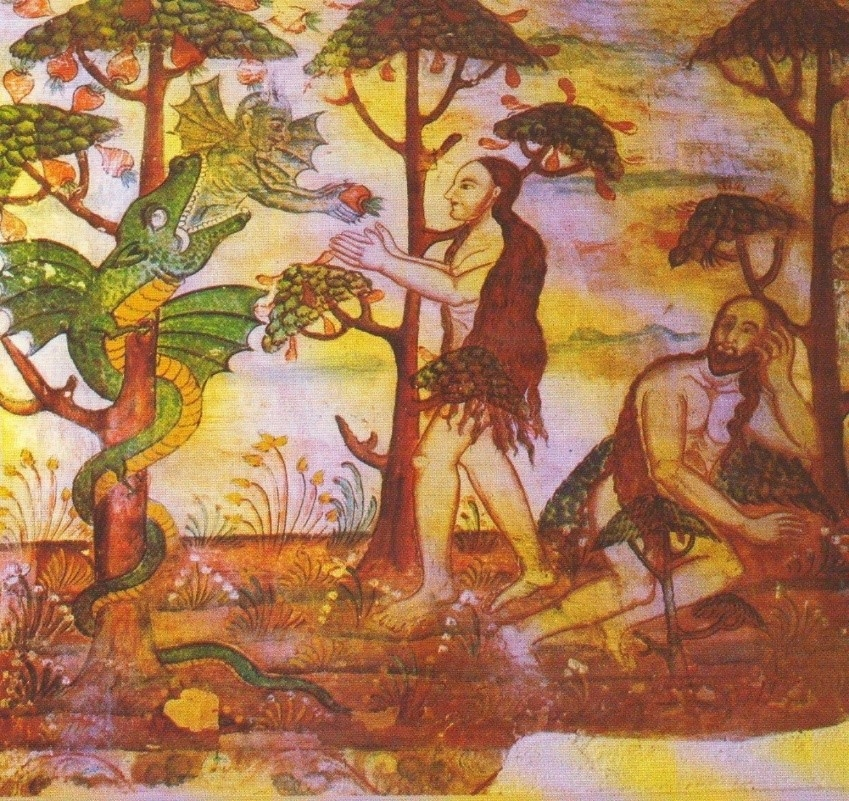
The predominant colours used in the paintings of St. Mary’s Jacobite Syrian Church at Angamali are yellow, red, white, blue, black and green.
2. St. Mary’s Church at Kanjoor in Ernakulam (10°08'29.7"N, 76°25'45.4"E)
St. Mary’s Church at Kanjoor (see fig. 9), located on the bank of the River Periyar near Aluva in Ernakulam District, is one of the well-known Christian pilgrimage centres in Kerala. This church was established in 1001 CE [3] and was modified and rebuilt in four subsequent phases. The mural paintings were executed during the second phase (fifteenth century CE) of renovation.
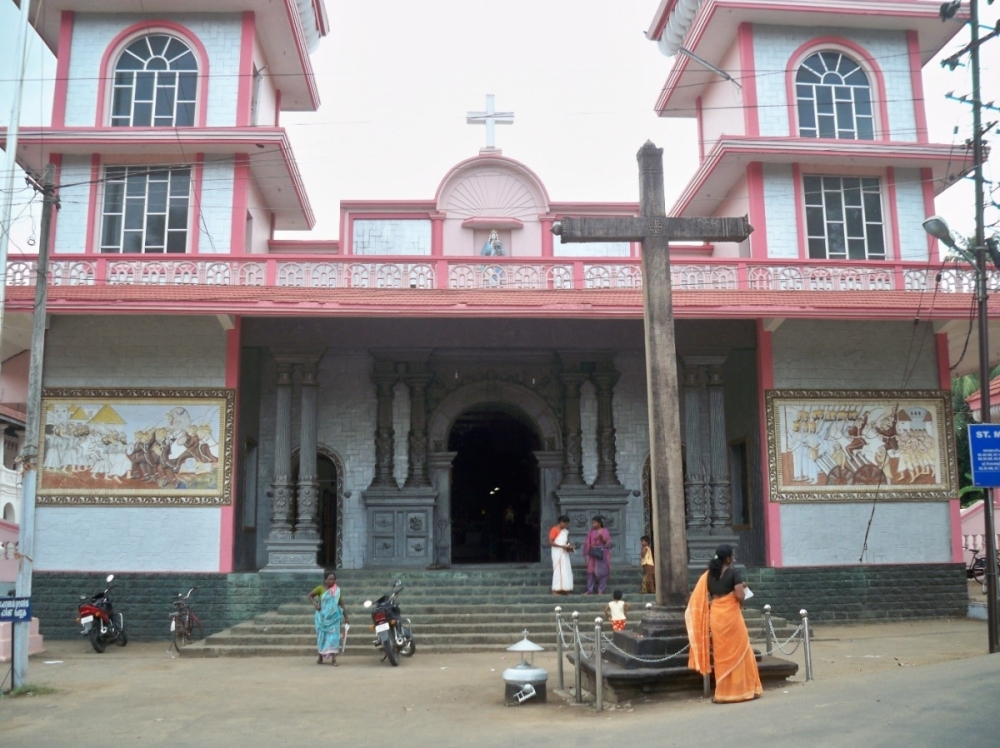
Mural Paintings
The important themes depicted in this church are the Annunciation, Moses receiving the Ten Commandments (see fig.10) and the Last Judgement (see fig. 11). These paintings have excellent decorative frames of floral motifs.
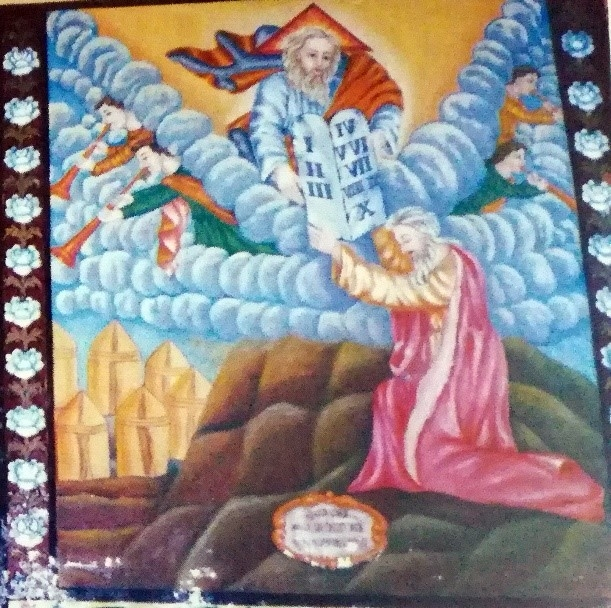
The panel of the Last Judgment is partially destroyed (see fig. 11). This panel has depictions of the Sun and the Moon symbolically denoting day and night. Both figures have human faces. This panel also shows holy people along with Jesus, Mary and St. Joseph, and an angel and a devil holding a book and judging skeletal figure.[4]
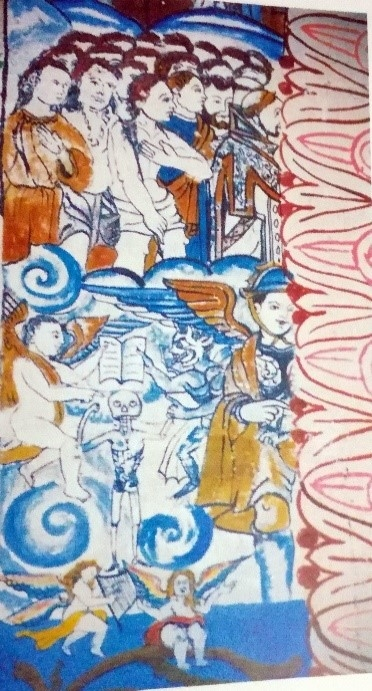
Blue and white are the predominant colours used here for painting. The selection of colours gives a pleasant character to the paintings. The figures depicted are easily identifiable and are smaller in size than the figures in the murals of the St. Mary’s Jacobite Syrian Church at Angamali.
3. St. Mary’s Orthodox Syrian Church at Kottayam (Cheriapalli) (9°35'50.4"N, 76°30'37.0"E)
St. Mary’s Orthodox Syrian Church, located in the town of Kottayam, is one of the well preserved early Orthodox churches in Kerala. It is believed to have been built in 1579 CE in the European style (see fig. 12). The interior wall of the altar of this church is lavishly embellished with mural paintings with both Biblical and non-Biblical themes.
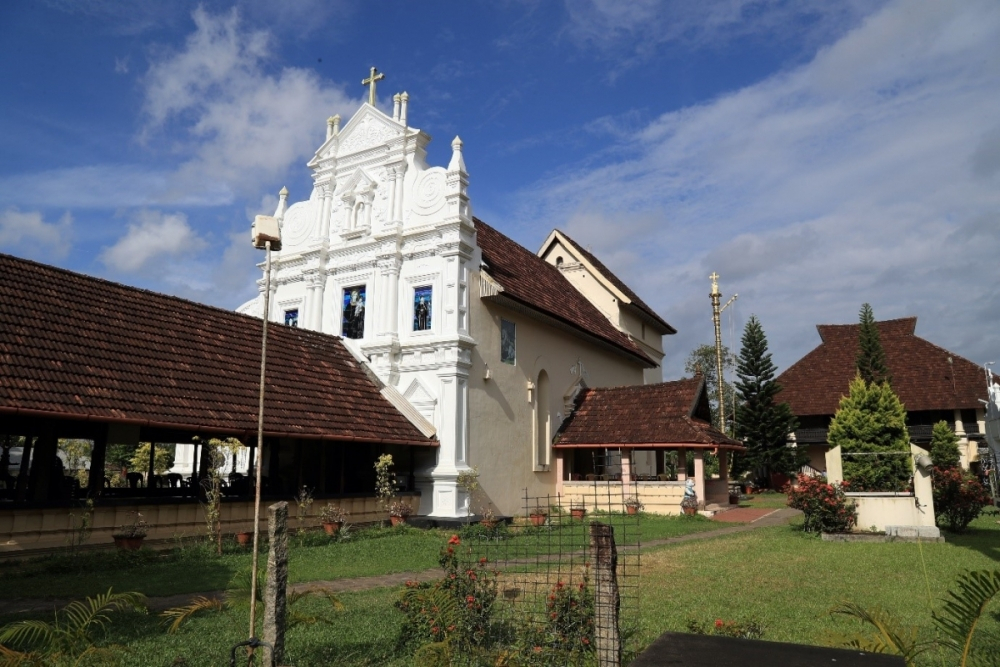
Mural Paintings
One of the best-preserved church murals of Kerala is in the madbaha of the St. Mary’s Orthodox Syrian Church at Kottayam. The important themes depicted here are the Crucifixion, the Last Supper (see fig. 13), the Scourging of Jesus, and the Trial of Christ (see fig 14). The scene of the Last Supper is the most enchanting of the paintings. Here, Jesus is shown sitting at the end of a table with the disciples in two rows facing him. The images are without border panels. Jesus is wearing an ochre-coloured costume. The background of the figures is filled with designs in yellow and white. The predominant colours of these church murals are dark green, ochre and yellow.
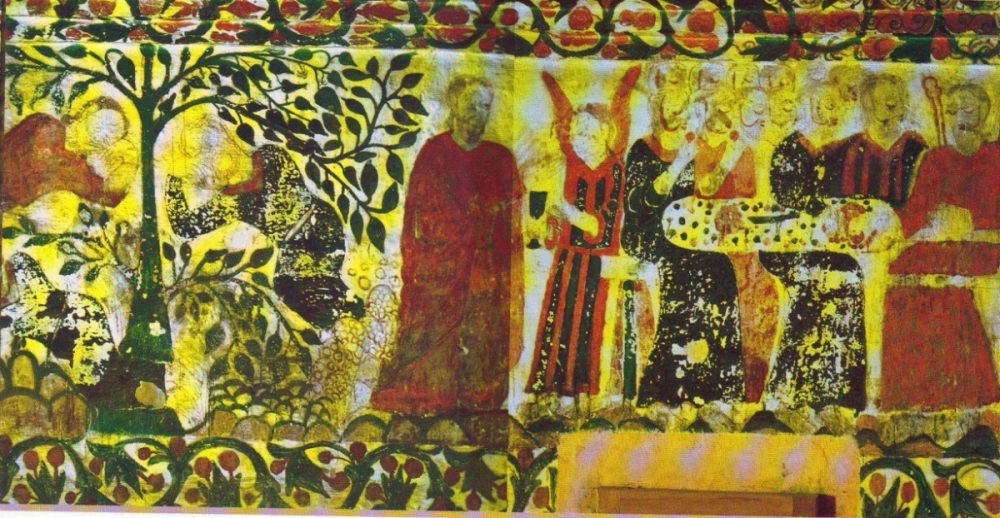
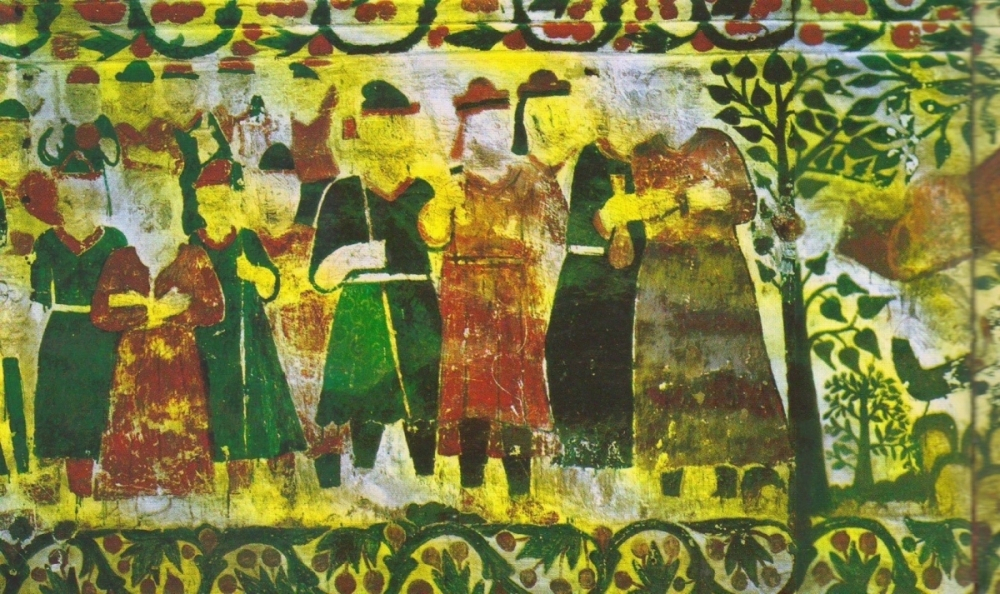
Discussion
Mural tradition in Kerala commenced around the eighth century CE. Early examples can be found on the walls of the rock-cut temple in Thirunanthikarai, now in the Kanyakumari District of Tamil Nadu.[5] Mural art tradition, which was essentially temple-centric, makes an entry into the palaces from the fifteenth century CE onwards. During the seventeenth century CE, a few churches also started executing mural paintings. These were stylistically and thematically different from the temple mural tradition, but the traditional mural painting techniques remained the same.
The Kerala mural tradition follows the frescobuono technique where the paintings are done on a prepared wall surface. In such paintings, there are two essential components. The initial component is the plastered wall surface and the second component is the paint for executing the work. The Kerala mural tradition generally carries five colours—yellow, red, green, black, and white. Hence, it is also called panchavarna (five-coloured). White is the surface colour of the wall itself and all the other pigments are obtained from plants and minerals. The primary colours used in Kerala church murals are ochre-yellow, Indian-red, blue or indigo, green, black, and white. Pigments play a vital role in temple murals. Different deities are shown in different colours in the temple murals. The differentiation is based on the character of each deity as described in the literature. White is generally used to represent satvaguna (spiritual positive aspect) of the deity (see fig.15). Red represents rajoguna (inclination towards power and materialistic wealth) (see fig. 16). Yellow represents both rajoguna and satvaguna (see fig. 17). Tamoguna (evil characteristics) is represented by using black (see fig: 18). Green and shades of blue represent a dharmic (righteous) character (see fig. 19).[6]
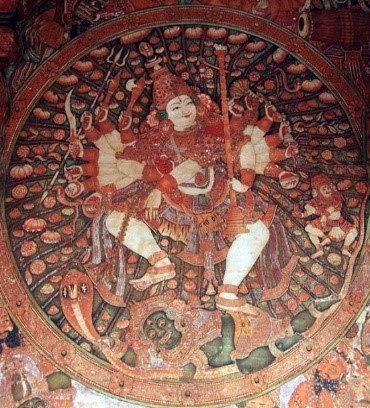
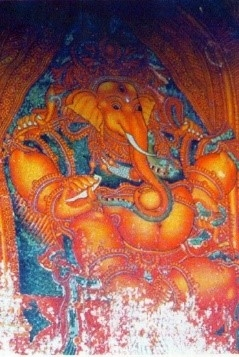
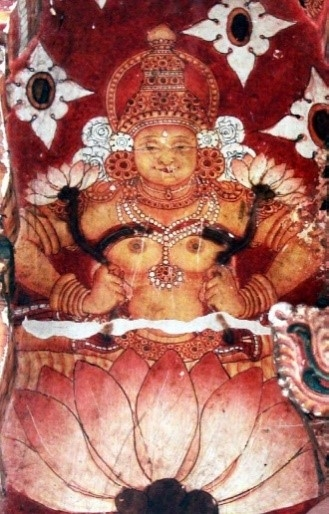
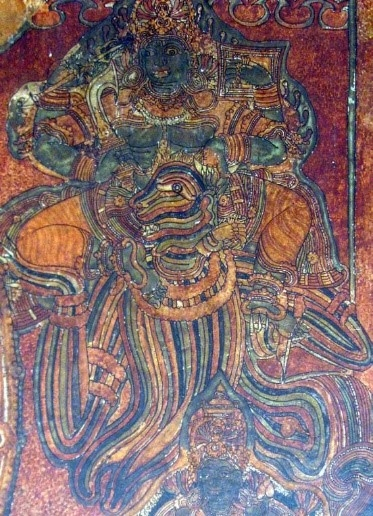
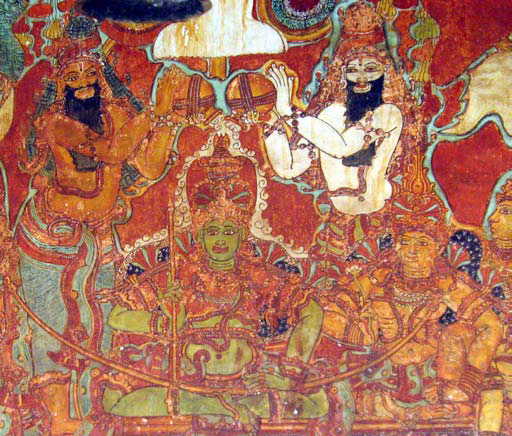
The colour scheme seen in the temple murals is not strictly followed in the church murals. The predominant colours used in church murals are dark blue and red. The blue colour is achieved using lapis lazuli, imported by the clergy from Damascus.[7] In Christian iconography, the blue symbolises purity of heaven and suggests a spiritual atmosphere. Usually, Mother Mary is depicted wearing blue. Red signifies energy, sacrifice and excitement. Usually, Jesus is depicted wearing red.
The mural painting tradition in Kerala temples has attained an indigenous style in iconographic temperament. About fifty distinctive iconographic themes are noticed in the temple murals of Kerala. The location of these themes on temple walls appears to be based on certain iconographic and vastu (Hindu architecture) parameters. They are distinctive in their bold outlining and vivid colour scheme. But in churches, the themes are portrayed using both indigenous and foreign styles. Themes are not assigned specific locations on the wall surfaces and are randomly arranged without the least attention to measurements. These features indicate the expression of artistic imagination. Occasionally, the whole scene is depicted without any demarcating frame. The figures in temple murals are adorned with various jewels and costumes. Decorative elements and embellishments are absent in church murals. Most of the holy figures in church paintings wear long robes.
In temples, paintings are mainly depicted on the exterior walls of the srikovil (Sanctum Santorum), nalambalam (Malayalam term, also called chuttambalam, which means a cloister around the main shrine or shrines) and gopuram (gateway). These areas are easily accessible to the public and open to natural elements such as rain, light, dust and humidity. But in churches, the paintings are depicted on the walls and ceilings of the altar, protected from the natural destructive forces and human vandalism. Hence, they are well preserved in comparison to the temple murals. These paintings in the churches stimulate the priests and devotees to remember, adore, and venerate the life of Christ.
Notes
[1] Thottathil Roy, S.J. 2012. ‘The Christian Mural Paintings in Kerala’ in Introduction to Kerala Studies, Volume-I, (eds. J.V. Vilanilam, Antony Palackal and Sunny Luke), p. 505.USA: International Institute for Scientific and Academic Collaboration.
[2] ibid, p. 508.
[3] ibid, p. 509.
[4] ibid, p. 511.
[5] Ramachandran, R. 2005. Painted Abode of Gods, Mural Traditions of Kerala, New Delhi: Indira Gandhi National Centre for the Arts, Vadehra Art Gallery, p. 41.
[6] Sheena, V.R. 2012. A Study of Temple Murals in Kerala, (unpublished PhD Dissertation). Thiruvananthapuram: Department of Archaeology, University of Kerala, p. 106.
[7] Shashibhooshan, M.G. 1997. Murals of Kerala, Kerala: Department of Public Relations, p. 137.
Bibliography
Jayashankar, S. Temples of Kerala, Thiruvananthapuram: Directorate of Census Operations. 1997.
Kramarisch, Stella. The Arts and Crafts of Travancore, Kochi: Paico Publishing House. 1948.
Kurien, Elizabeth P., Sunny Luke, Jacob Vellian, Jacob Kollaparambil, and Celine Charath. ‘Knanaya Christians in Kerala: History and Cultural Practices’, in Introduction to Kerala Studies, Volume-I (eds. J.V. Vilanilam, Antony Palackal and Sunny Luke), pp. 367-392. USA: International Institute for Scientific and Academic Collaboration. 2012.
Ramachandran, R. Painted Abode of Gods, Mural Traditions of Kerala, New Delhi: Indira Gandhi National Centre for the Arts, Vadehra Art Gallery. 2005.
Sarkar, H. Monuments of Kerala, New Delhi: Archaeological Survey of India. 1973.
Shashibhooshan, M.G. Murals of Kerala, Kerala: Department of Public Relations. 1997.
Sheena, V.R. A Study of Temple Murals in Kerala, (unpublished PhD Dissertation). Thiruvananthapuram: Department of Archaeology, University of Kerala. 2012.
Thomas, V.V. ‘The History of Christianity in Kerala: A Perspective from the Underprivileged’, in Introduction to Kerala Studies, Volume-I, (eds. J.V. Vilanilam, Antony Palackal and Sunny Luke), pp. 347-366. USA: International Institute for Scientific and Academic Collaboration. 2012.
Thottathil Roy, S.J. ‘The Christian Mural Paintings in Kerala’ in Introduction to Kerala Studies, Volume-I, (eds. J.V. Vilanilam, Antony Palackal and Sunny Luke), pp. 501-514.USA: International Institute for Scientific and Academic Collaboration. 2012.
